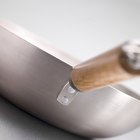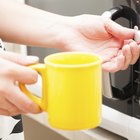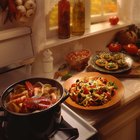
Glass and ceramic cookware goes from oven to table, with leftover storage in the same container in the refrigerator or freezer. Corning issued the first catalog of Pyrex glass flasks and beakers in 1915 and forever changed cooking with oven-safe glass. Corning developed ceramic cookware suitable for the stove top with the 1958 introduction of CorningWare. Other companies followed Corning in the development of glass and ceramic cookware so that today's cook has many choices for fast casseroles and one-dish meals. This cookware also helps busy moms put a nutritious dinner on the table every evening by affording them an easy way to pre-make their favorite family meals and have foods ready to go straight from the refrigerator to stovetop or oven.
Options
The white or colored products used in today's kitchens are glass, ceramic or stoneware and the composition is often irrelevant to the cook as long it is safe. Glass and ceramic bakeware saves energy; the cooking temperature is 25 degrees less than a metal pan, reports El Paso Electric. The glass products are lighter weight than ceramics and may break more easily. These products are microwave-safe and dishwasher-safe.
Glass
Glass is not always transparent or translucent, as much kitchen glassware is white. Corning's SimplyLite is Vitrelle, a laminated glass product much like Corelle used for dinnerware. SimplyLite is oven and freezer safe and perfect for table service of family casseroles. Make a casserole and freeze it in the bakeware for later in the week. Pyrex and Anchor Hocking make translucent and white glass bakeware along with clear tempered glass.
Most glass bakeware is not safe for stove top use, but Pyrex developed a Flameware coffee pot and teapot in a clear glass much like beaker or laboratory glass that withstands cooktop use. Corning made Visions products of glass ceramic for the cooktop. These pots are see-through for convenience and look like glass. The Visions products are safe for the broiler and microwave without the Pyrex lids.
Other Uses
Tested and approved glass and ceramic cookware is safe for refrigerator storage as well as cooking. Use your cookware for microwave cooking of nutritious vegetables and for warming leftovers for the family. If you have limited glass or ceramic cookware or limited freezer space, you may want to remove the casserole from the cookware and place it in plastic wrap, then foil for storage in the freezer. When you are ready to serve the casserole, remove the foil and plastic wrap and return the casserole to the original glass or ceramic pan for baking or microwave cooking.
Safety
Lead is a concern in glass and ceramic cookware as small quantities of lead are harmful to children. Lead poisoning occurs without obvious symptoms but can affect babies before birth, reports the U. S. Environmental Protection Agency. Protect your family by using glass and ceramics tested and approved for cookware. The EPA warns not to store or serve food in glazed pottery from foreign countries. The EPA also warns that leaching occurs with storage of liquids in lead crystal. When using glass or ceramics in your kitchen, use tested products only. Review the literature for new items, and wash glass or ceramic cookware with soapy water before use.
Related Articles

Can You Cook Frozen Dinners in Glass?

Is Corning Cookware Safe?

The Safety of Refrigerators and ...

Skillets That Go in the Oven

Can You Microwave Ceramic Mugs?

How to Use Smartware Cookware
What Kind of Cans Are Used for Canned ...

What Are the Dangers of Cooking With ...

What Is Better for Cookware: Glass, ...
How Do I Know If My TV Dinner Has BPA?

What Is the Highest Temperature That ...
How to Lower Cooking Times & ...

Cooking With Stoneware

How to Cook in Ceramic Bakeware

Appliances That Use Solar Energy

Is It Harmful to Cook Meat in Plastic?

Glass Pie Pan Baking Tips

What Are the Types of Fine China?

Characteristics of Oven-proof Plates

What Are the Dangers of Tantalum?
References
Writer Bio
Linda Richard has been a legal writer and antiques appraiser for more than 25 years, and has been writing online for more than 12 years. Richard holds a bachelor's degree in English and business administration. She has operated a small business for more than 20 years. She and her husband enjoy remodeling old houses and are currently working on a 1970s home.
Photo Credits
Jupiterimages/Comstock/Getty Images